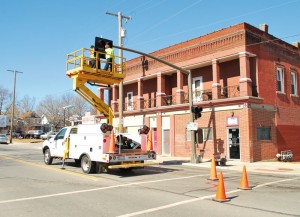
By LESLIE COLLINS
Northeast News
July 24, 2013
Kansas City City Council approved re-instating the operation of traffic signals at 16 intersections July 18, but it wasn’t without qualms.
“This whole process is just so disturbing,” Mayor Pro Tem Cindy Circo said. “Turn off or turn on is an absolute false choice that I’m being forced to make. There are so many options and there should be a comprehensive game plan. I’m highly disappointed.”
The traffic light debacle began last October when the city deactivated traffic signals at 37 intersections throughout the city with no advance warning to area residents or school districts. Signals were programmed to flash red or yellow and the city installed four-way stop signs at a number of intersections, including St. John Avenue and Hardesty; St. John Avenue and Van Brunt; and St. John Avenue and Belmont. In addition, the pedestrian signals located at St. John and Quincy and St. John and Topping, both near grade schools, were deactivated and programmed to flash yellow. Due to public protest, the city installed a HAWK (High-Intensity Activated crossWalK) signal at St. John and Quincy. St. John and Topping is included in the list of 16 intersections and the pedestrian crosswalk signal will be activated in the near future.
Of the 250 intersections the city studied, 144 intersections contained “unwarranted” traffic signals, according to federal guidelines listed in the Manual on Uniform Traffic Control Devices (MUTCD). To be warranted, a traffic signal must meet at least one of nine warrants.
City Council member Jermaine Reed accused the city’s Public Works Department of telling “tales,” like “this is not in the budget” and others to justify removing the signals.
“When we started this discussion, we were hiding behind the book (MUTCD). We can’t do that anymore,” Reed said.
Kansas City Public Schools (KCPS) Board of Education member Joseph Jackson said the city’s traffic studies were flawed and that deactivating the traffic signals near schools put students’ safety at risk.
“Many students have to walk to school,” Jackson said.
When the school district requested a copy of the city’s traffic studies for intersections near schools, school officials noticed several problems and requested a recount, he said. City officials noted pedestrian counts weren’t high enough to meet the MUTCD warrant. However, one traffic study recount was conducted during inclement weather in December, right before winter break, and a number of parents kept their children at home. The next recount occurred at Indiana and 39th on March 22, the Friday before spring break, from 2 p.m. to 3 p.m. Jackson pointed out that Central High School releases students at 2:40 p.m. and Martin Luther King Jr. Elementary releases students at 3:25 p.m. By the time a student from Central would have made it to the intersection, the traffic engineer would have already been gone, he said. The most “egregious” traffic study, he said, occurred on March 28 on a Thursday during spring break and the day before Good Friday.
“How could you say you honestly gave us a fair count?” Jackson said during the city’s July 11 Transportation and Infrastructure Committee meeting.
Sherri McIntyre, director of the Public Works Department, said the department will ensure it works with school districts in the future regarding changes to intersections.
City Council member John Sharp commended the ordinance to re-instate the traffic signals, stating that traffic counts only give a snapshot of the full picture and that neighborhood residents and area schools know the intersections more intimately. According to Ordinance 130495, citizens and KCPS expressed concerns over the safety of pedestrians and motorists at the 16 intersections, which is one of the main reasons for the city re-instating the signals. In addition, the ordinance calls for the development of a comprehensive plan regarding the city’s traffic signal infrastructure.
Re-instating the signals does have long-term implications, however. While the city has enough funding to operate and perform routine maintenance on the traffic signals, those signals will eventually need to be replaced at the tune of $250,000 each, according to City Traffic Engineer Wei Sun. Replacing the signals isn’t in the city’s budget, he said. Traffic signals at the 16 intersections date back to the 1940s and 1950s and replacement parts are becoming scarce. In addition, the outdated signals can’t be synchronized with the city’s digital traffic signals. On average, it costs $5,000 per year to operate each signal. That’s funding that could be used for other projects, like striping crosswalks and other maintenance activities to improve safety and walkability, said McIntyre.
Circo said turning every signal back on isn’t the answer and that other options should be explored, like HAWK signals, flashing stop signs, among others.
“This city has great infrastructure needs with limited dollars,” Circo said. “A turn off or turn on only keeps us with status quo and status quo truly isn’t good enough.
“When it (outdated traffic signals) shuts down and it’s inoperable, then what do we do? We don’t have a game plan.”
Traffic signals to be restored
Benton Blvd & 27th • Benton Blvd & 35th • Benton Blvd & 39th • Benton Blvd & Walrond/Linwood Blvd •Cleveland Ave & 43rd • Cleveland Ave & Linwood Blvd • Indiana Ave & 35th • Indiana Ave & 39th • Jackson Ave & Linwood Blvd • Woodland Ave & 18th • St. John Ave & Topping Ave • The Paseo & 55th • The Paseo & 59th • Armour Blvd & Warwick Blvd • Meyer Blvd & Oak • Gregory Blvd & Main • State Line Road & 63rd Terrace/Tomahawk Road, pending negotiations with Mission Hills
















